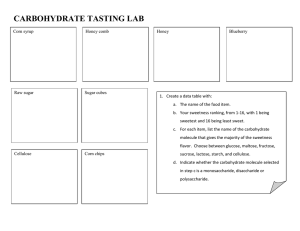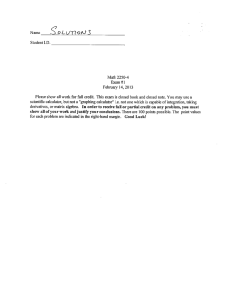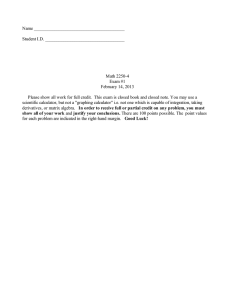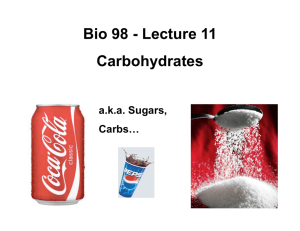Omnivores Dilemma, by Michael Pollan
advertisement
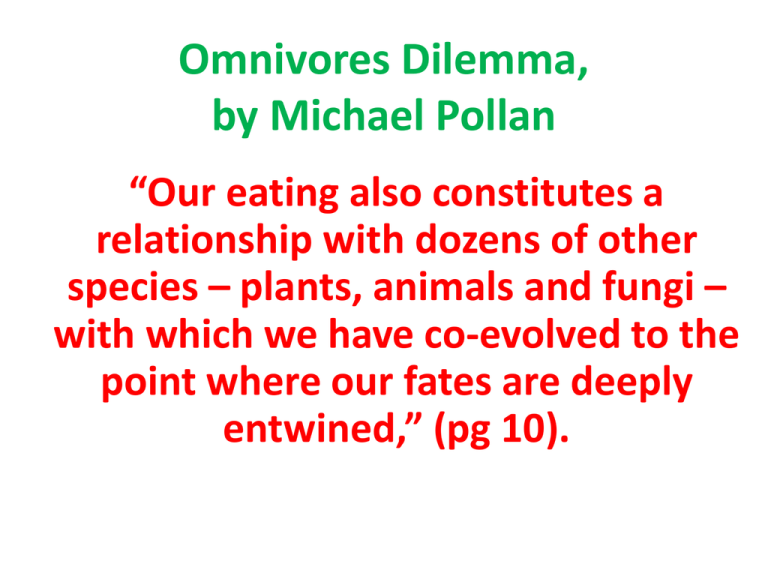
Omnivores Dilemma, by Michael Pollan “Our eating also constitutes a relationship with dozens of other species – plants, animals and fungi – with which we have co-evolved to the point where our fates are deeply entwined,” (pg 10). Pollan writes: • About 1/5th of our meals are eaten in cars, and 1/3rd of children eat fast foods daily. • What is our food chain? Huntergatherer, organic or industrial? • “What am I eating? Where in the world did it come from?” (17). Energy: Sun to Plants to Sugar Energy: Sun to Plants to Sugars CARBOHYDRATES SUGARS = Fuel for cells ALCOHOLS = sugars with an -OH STARCH = plant energy storage CELLULOSE = plant structure + support • GLYCOGEN = short term animal energy storage • • • • What are these things? • • • • • • • • • Mono, di, triglycerides Trans fats TBHQ Maltose High fructose corn syrup (HFCS) Xanthan gum Lecithin Ascorbic acid Lactic acid Xanthan gum = Carbohydrate http://en.wikipedia.org/wiki/Xanthan_gum • Xanthan gum is a polysaccharide, derived from the bacterial coat of Xanthomonas campestris, used as a food additive andrheology modifier,[2] commonly used as a food thickening agent (in salad dressings, for example) and a stabilizer (in cosmetic products, for example, to prevent ingredients from separating). It is produced by the fermentation of glucose, sucrose, or lactoseby the Xanthomonas campestris bacterium. Maltose is a malt sugar, a disaccharide High Fructose Corn Syrup is about 50% Fructose + 50% Glucose CARBOHYDRATES = C+H Fructose is the sweetest refined sweetner Estimated intakes of total fructose (•), free fructose (▴), and high-fructose corn syrup (HFCS, ♦) in relation to trends in the prevalence of overweight (▪) and obesity (x) in the United States. Bray G A et al. Am J Clin Nutr 2004;79:537-543 ©2004 by American Society for Nutrition Alpha amylase + Glucose isomerase • Enzyme include Alpha amylase to break up the starch, and glucose isomerase, which led to the commercialization of high fructose corn syrups. http://www.elmhurst.edu/~chm/vchembook/548HFsyrup.html high-fructose corn syrup • Consumption of high-fructose corn syrup in beverages may play a role in the epidemic of obesity American Journal of Clinical Nutrition, 2004 http://www.ajcn.org/content/79/4/537.short • The digestion, absorption, and metabolism of fructose differ from those of glucose. Unlike glucose, fructose does not stimulate insulin secretion. • Because insulin acts as key signals in the regulation of food intake and body weight, this suggests that dietary fructose may contribute to increased energy intake and weight gain. What are Lipids? • • • • • Lipids are Fats, Oils, Waxes, Steroids FATS are : Glycerol + 3 Fatty Acids Lipids are HYDROPHOBIC Not very soluble (dissolvable) in water Three types: (generally) • Triglycerides – energy storage • Phospholipids -membranes • Sterols - hormones LIPIDS ! • Mono, di, triglycerides • Lecithin • Trans fats Monoglyceride FATS = an alcohol + carbon chain Triglyceride Lecithin – a lipid • Lecithin is a major structural component of biological membranes1,2. Lecithin + related phospholipids form as bilayer structures where the hydrophilic head groups are orientated towards the watery surface and the hydrophobic hydrocarbon chains towards the inside. http://www.nature.com/nature/journal/v281/n5731/abs/281499a0.html PhosphoLipids = Carbon Chains + Phosphate Heads • The fatty acids of unsaturated fats (plant oils) contain double bonds – These prevent them from solidifying at room temperature • Saturated fats (lard) lack double bonds – They are solid at room temperature Figure 3.8C SATURATION OF FATTY ACIDS Tertiary butylhydroquinone, or TBHQ • Stabilization of Nrf2 by tBHQ Confers Protection against Oxidative Stress-Induced Cell Death in Human Neural Stem Cells http://toxsci.oxfordjournals.org/content/83/2/313.short • The present study is aimed to determine whether increased protein stability is a mechanism by which quinone compounds, like tertbutylhydroquinone (tBHQ), may enhance Nrf2-mediated transcriptional activation and subsequent antioxidant protection. The food additive butylated hydroxyanisole (BHA) has been shown to induce gastrointestinal hyperplasia in rodents by an unknown mechanism. We therefore analysed the effect of BHA and its primary metabolites tertbutylhydroquinone (TBHQ) and tertbutylquinone (TBQ) on 8-oxo-deoxyguanosine formation and labelling indices in human lymphocytes in vitro. http://carcin.oxfordjournals.org/content/16/3/507 Plant Stomata open + close for gas exchange, but also lose water this way. Problem with C3 Photosynthesis • Photorespiration in C3 plants: – When its hot out, stomata close up…why is this a problem? CO2 can’t get into cell and O2 can’t leave – O2 then enters Calvin Cycle – Sugar production stops because there’s no carbon source C4 plants also photosynthesize “better” with stomates closed and reduce water losses in leaves. The C4 photosynthetic plants also take in more Carbon-13 isotopes. Corn, or maize (Zea mays), was domesticated from a wild grass called Teosinte about 6300 years ago in Mexico. Hybrid Corn Yields • 1920’s 20 bushels/ acre • 1930’s first hybrids • 1950’s 75 bushels/acre • Now 180 bushels/acre YieldGard VT Triple YieldGard VT Triple®: the stacked trait with enhanced hybrid performance https://www.dekalb.ca/Eastern/en-CA/Products/Corn/Traits/Pages/YieldGardVTTriple.aspx According to the invention, a hybrid maize plant, designated as 34H31, are produced by crossing two Pioneer Hi-Bred International, Inc. proprietary inbred maize lines. This invention relates to the hybrid seed 34H31, the hybrid plant produced from the seed, and variants, mutants, and trivial modifications of hybrid 34H31 http://www.patentstorm.us/patents/6897360.html Nitrogen fixation • The Haber process, also called the Haber–Bosch process, is the nitrogen fixation reaction of nitrogen gas and hydrogen gas, over an catalyst, which is used to industrially produce ammonia. http://en.wikipedia.org/wiki/Haber_process • It is estimated that half of the protein within human beings is made of nitrogen that was originally fixed by this process, the remainder was produced by nitrogen fixing bacteria and archaea. Bovine spongiform encephalopathy • Epidemiological studies showed the vehicle of infection to be meat and bone meal that had been incorporated into concentrated feedstuffs as a protein-rich supplement. • The outbreak was probably started by scrapie infection of cattle, but the epidemic was driven by the recycling of infected cattle material within the cattle population http://faorlc.cgnet.com/es/prioridades/transfron/eeb/pdf/bse.pdf BSE (Bovine Spongiform Encephalopathy, or Mad Cow Disease) • BSE (bovine spongiform encephalopathy) is a nervous system disorder of cattle from an infection by an protein called a prion. • The nature of the transmissible agent is not well understood. For reasons that are not yet understood, the normal prion protein changes into a pathogenic (harmful) form that then damages the central nervous system of cattle. http://www.cdc.gov/ncidod/dvrd/bse/

